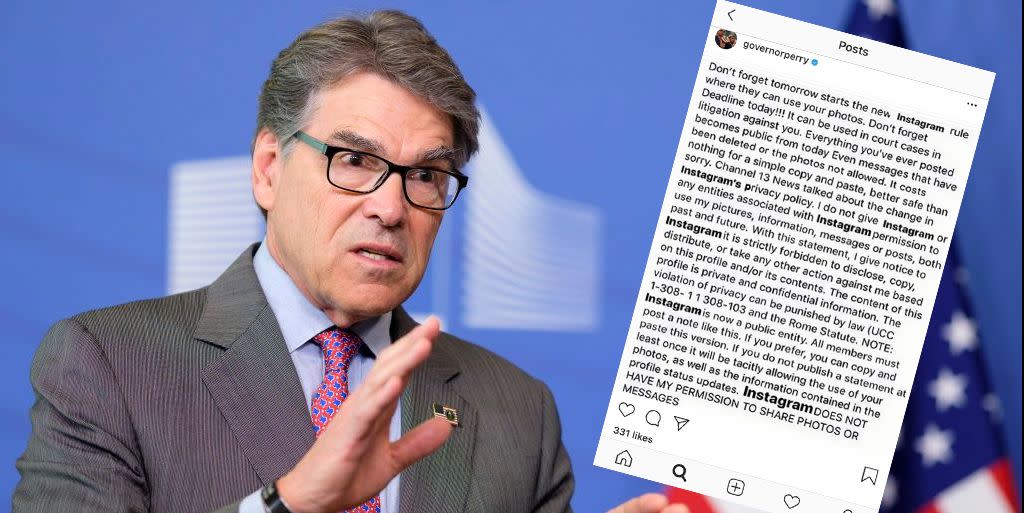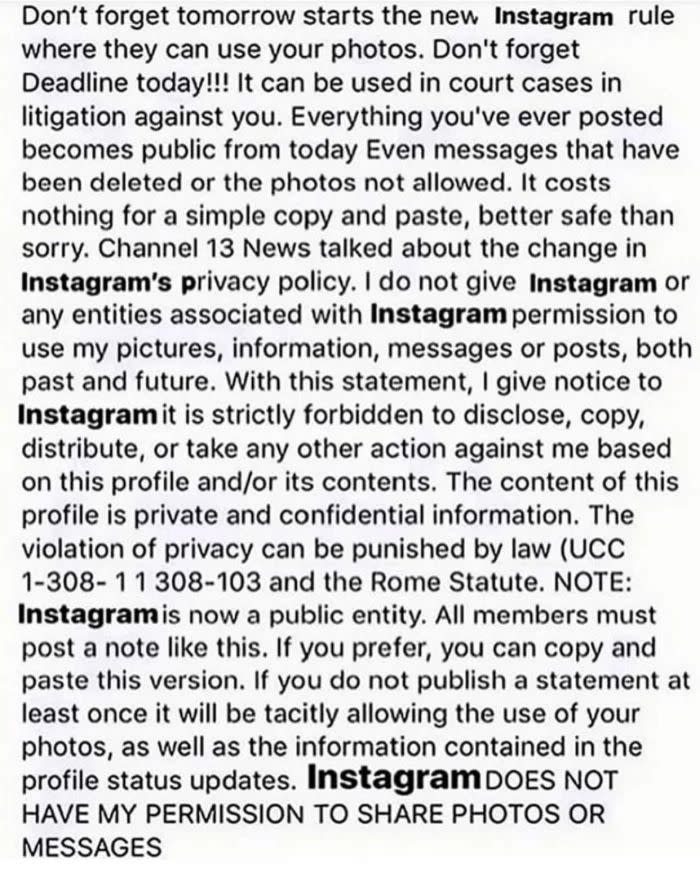No, That Instagram Privacy Hoax Isn’t Real. It Never Is.

Tons of celebrities shared an Instagram post this week to protect their photos on the app. It was fake.
The Instagram hoax actually dates back to 2012. It was fake then, it's fake now, and it will be fake in the future.
The best way to control your data online is to always read the terms of use for any app and be extra diligent about processing and spreading questionable news.
Julia Roberts, Rob Lowe, and even current Secretary of Energy Rick Perry were among the many celebrities, politicians, and regular people who recently shared this Instagram post in an effort to protect their photos:

Like lots of less famous users, they didn't understand that the news was a complete hoax.
What Is the Instagram Hoax?
This particular hoax isn’t new. It first popped up on Facebook in 2012 and again in 2015 before the latest round of celebrity postings. This time around, people who shared the image on Instagram did so to protect themselves. The post states that:
“with this statement, I give notice to Instagram [that] it is strictly forbidden to disclose, copy, distribute, or take any other action against me based on this profile and/or its contents.”
All of which is in response to a false rumor that Instagram will have ownership of your content, ambiguously, “tomorrow.”
As you may have guessed, the incendiary and alarming post has no merit.
Stephanie Otway, a spokesperson for Facebook, the parent company of Instagram, told CBS News, “There's no truth to this post.”
Of course there isn’t. But there is a mass misunderstanding of the social platforms that have become the critical infrastructure of our lives. Instagram accesses and analyzes a variety of posted content including hashtags, comments, keywords, and geotags. Then it uses this information to create customer segments that it sells to marketers. Marketers then serve ads via the platform to those identified.
In joining the platform, you’ve agreed to let your data be used, anonymized, and sold in exchange for advertisers advertising to you. Instagram wants your data so that it can sell it to those who want to sell things to you. The hoax allegations don’t make sense in the context of the Instagram business model.
How Did the Instagram Hoax Spread?
Think of a social hoax like a chain letter, except in this case, rather than receiving an email from a Nigerian prince in their inbox, Instagrammers saw the image posted by someone they trusted. And real-life trust of a friend or a celebrity translates into social trust, i.e. we trust that something they post is real. This is called social legitimacy.
Celebrities, in the eyes of the general public (and apparently each other), have more social legitimacy than normies. So when a celebrity shares a piece of content, it has the propensity to spread much further than anyone else’s post. In fact, this is the theory that underlies influencer marketing in general: Those with more social legitimacy can sell things better than brand accounts.
Social legitimacy is why celebrity content spreads more quickly than average. Individuals feel comfortable reposting celebrity content because people like Judd Apatow or Usher did first. YouTube Head of Culture and Trends Kevin Allocca explained how content goes viral in this 2011 Ted Talk, and the basics remain the same now:
Content comes out that has an emotional draw or unexpectedness (in this case fear of privacy loss).
Influencers share that content.
Communities share that content further.
In this case, celebrities shared the content of other celebrities until enough people legitimized it that everyone assumed it was real. The problem? In an era in which fake news is more likely to spread than legitimate news, we need to look at the content posted on social media with more consideration.
We also need more social “badge-checkers,” or those people who question content that is posted and help to stop it from being spread. The “badge-checker” concept is one that Geoffrey Miller describes in his book, Spent: Sex, Evolution and Consumer Behavior. While we sometimes call these people trolls, they play a crucial role in society.
Trolls—err, badge-checkers—help us determine what is real or fake. On social media, they ask questions and challenge the perceived truths. By asking about legitimacy, they help to remind the original posters to check their content and prove what they post.
Instead of bullying, now more than ever we need badge-checkers to ask questions and feel comfortable responding, engaging in debate, and admitting when they’re wrong. As our country has become more divisive, we have less tolerance for those who question, dispute, and debate. But we’ve also lost the ability to do so, and with it, the ability to fact-check others.
How to Spot an Internet Hoax
Don't want to be a troll? Then be a badge-checker. There are ways that you can effectively spot and call out a social media hoax. All it takes is a small amount of diligence and a bit of curiosity about what you see posted.
“Google can be a great resource for confirming the validity of privacy scare tactics on social media,” says personal security expert Kristen Kozinski, of DontClickOnThat.com. “Searching for information on sites like Snopes and major news sources can confirm if rumors are true or not.”
A cursory Google search on this topic over the weekend would have confirmed some notable flaws not limited to, but including, the one of the legal conventions mentioned. The Rome Statute created the International Criminal Court, which prosecutes those who commit genocide or war crimes. It’s our guess that while many celebrities shared the Instagram post, international criminal lawyer Amal Clooney would have immediately known it was a hoax. It clearly does not relate to anything alluded to in the post.
Beyond that, the typos and the notable disconnection to the Instagram business model should have been clues.
Consumer marketing expert Rebecca Batterman offers additional tips for protecting yourself from the spread of fake news or online hoaxes:
Question Everything. Be a proactive vs. reactive message receiver and don’t take everything at face value. That includes direct messages through social media, social media posts, and even what you hear on the news. Things aren’t always what they seem.
Remember: You’re Your Strongest Consumer Advocate Research. Look for supporting information and credible sources to support the message.
Check the Terms of Agreement. Especially on social media, when you engage on a company platform, you opt into the terms of the agreement. Read those terms! You may be surprised by what you’ve already agreed to. A general rule is that the platform belongs to the company on which you’re publishing.
Check the Terms of Use. On Instagram, go to Settings-> About-> Terms of Use. It’s all right there.
Know That Posts Are Only Posts. Posting an “opt-in” or “opt-out” post as content on your page does not remove the opt-in and the terms that you agreed to upon signing up. It’s just content.
The simplest advice of all? “It’s not always a sure thing. If the post looks sketchy, it probably is,” says Batterman.
You Might Also Like

